
Automating the First Hello
Building a digital-first onboarding experience that transformed manual processes into a streamlined, scalable platform for new hire success.
Process Automation
User Research
Workflow Design
Compliance
65%
Reduced onboarding time per month.
100%
Documentation compliance prior to start date.
75%
Reduced data entry errors
95%
Multi-location Process
Project Overview
I transformed Company’s outdated, paper-based onboarding process into a modern, digital-first platform that streamlined workflows, reduced errors, and ensured compliance. The new system empowered People Ops, managers, and employees with clarity, efficiency, and inclusivity. This project wasn’t just about saving time, it was about creating a welcoming, scalable onboarding experience for every new hire.
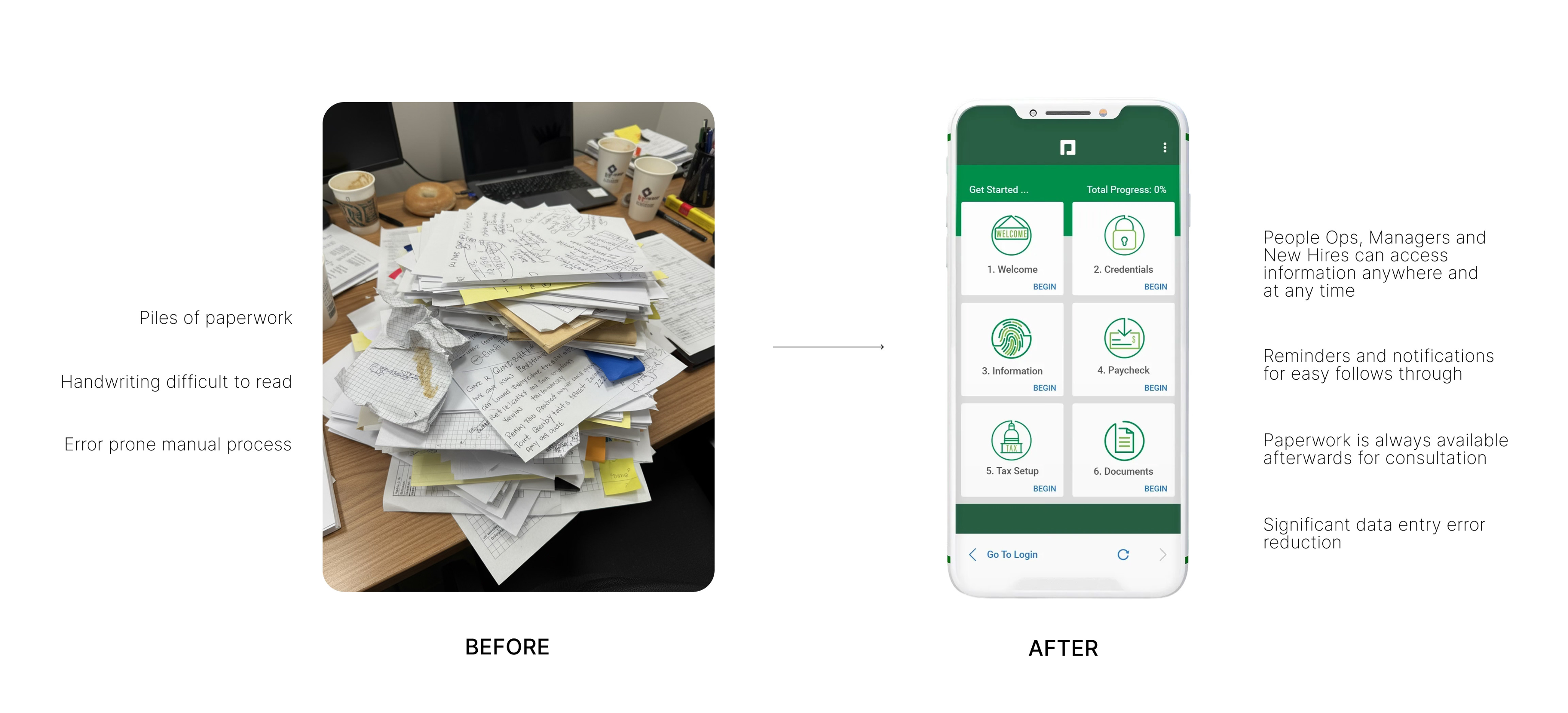
My role
Process Design Lead & Implementation Manager
- Led discovery with HR and managers to identify inefficiencies and compliance risks.
- Designed and implemented automated workflows in Paycom to reduce errors.
- Guided the transition to a digital platform, standardizing processes across locations.
- Built a centralized tracking system in Monday.com for real-time onboarding visibility.
Project goals
- Replace manual workflows with a scalable, automated system.
- Reduce potential compliance risks and eliminate data entry errors.
- Empower managers and employees with self-service onboarding tools.
- Provide bilingual accessibility to support a diverse workforce
Impact
- Cut onboarding processing time by 65%, saving 26+ HR hours/month.
- Reduced data entry errors by 75%, improving compliance and accuracy.
- Raised documentation compliance to 100% pre-start (from 85%).
- Increased onboarding completion rate from 50% → 95% within 7 days, ensuring timely access to systems and perks.
The Challenge
Company’s rapid growth and high turnover created a pressing need for a scalable, structured onboarding solution. The existing manual, paper-based process was slow, error-prone, and failed to support a diverse bilingual workforce. Without visibility into progress, both employees and managers experienced delays and frustration, while People Ops carried the burden of repetitive administrative work.
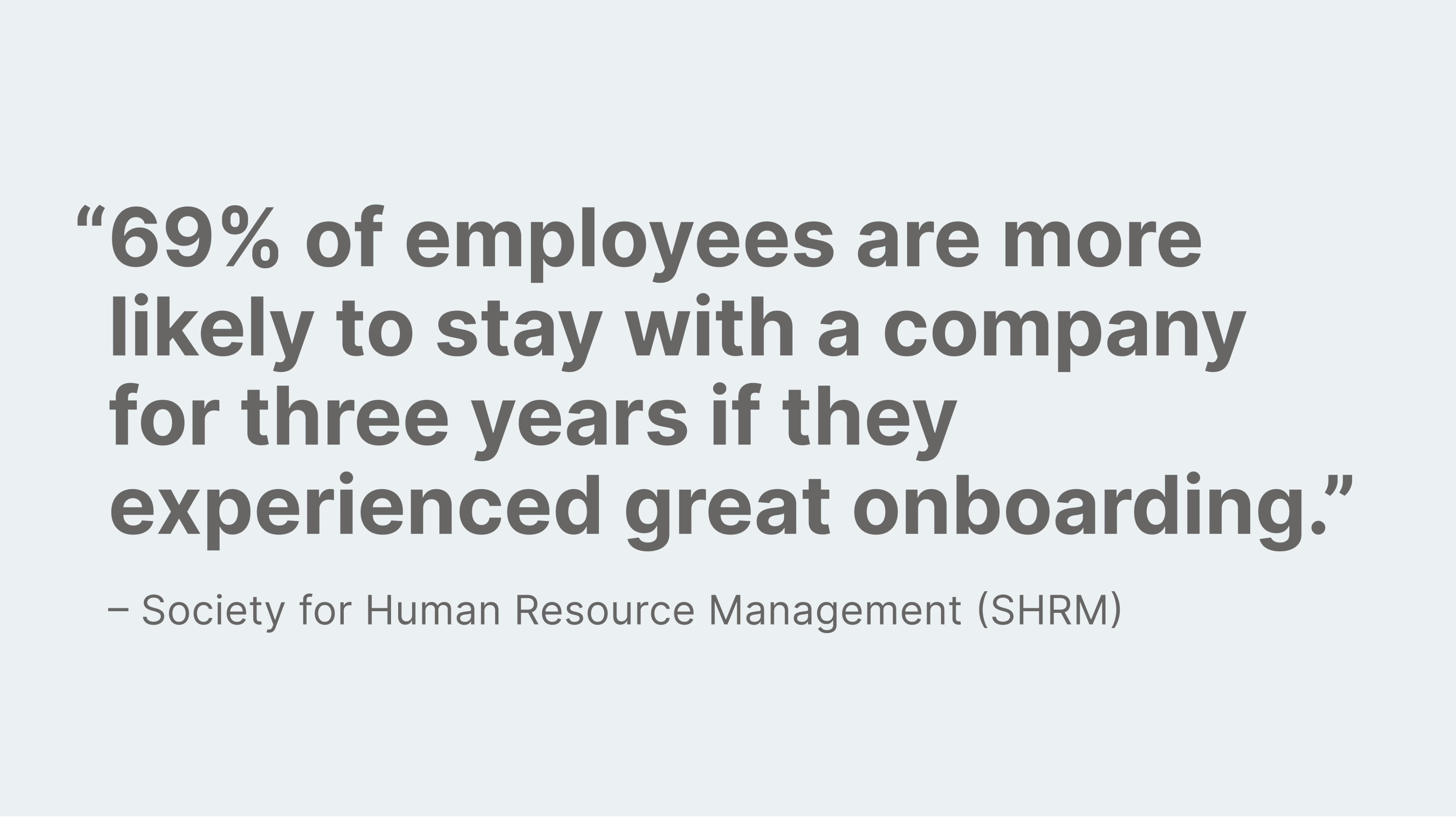
Current State Problems
Manual Paper-Based Process
Required bilingual staff to process all documentation by hand.
High Error Rates
Manual data entry led to compliance risks and processing delays.
Fragmented Workflow
Managers and employees lacked visibility into onboarding progress.
Excessive HR Workload
Required bilingual staff to process all documentation by hand.
Business Impact
Digital Centralization
To automate all onboarding tasks within the HRIS platform.
Standardization & Scalability
A consistent process that adapts to seasonal hiring and growth.
Self-Service Capabilities
Tools that allow managers and employees to complete onboarding independently.
Bilingual Accessibility
English and Spanish resources to support a diverse workforce.
User Center Design Process
Discovery PHASE
To design a seamless and inclusive onboarding experience, I conducted research to uncover inefficiencies, pain points, and opportunities for improvement.
User research &
stakeholder interviews
Pain points & challenges
Identified frustrations, inefficiencies, and compliance risks in the current manual process.
Time & effort analysis
Measured how long each onboarding task took, from locating documents in the file share to employee system access.
Legal & Compliance considerations
Determined which documents, signatures and approvals were essential to remain compliant.
Training & accountability needs
Evaluated how involved managers should be in onboarding and defined their responsibilities.
Process mapping &
requirement gathering
Document management
Tracked where People Ops accessed and printed forms, when documents were distributed, and how they were collected.
Related processes
Mapped out the dependencies between onboarding and other People Ops workflows to streamline handoffs and prevent bottlenecks.
Task ownership
Defined clear responsibilities between People Ops, managers, and new hires.
Industry research
Applied SHRM recommendations, benchmarked case studies, and studied the psychological impact of onboarding on retention and belonging.

Key Research Insights
Through comprehensive research, I identified critical pain points and opportunities to transform the onboarding process:
- Manual processes slowed onboarding and increased HR workload.
- Compliance risks grew due to fragmented workflows and undocumented handoffs.
- Employees lacked visibility, leading to disengagement and frustration.
- Managers wanted clearer accountability to better support their teams.
- Automation + bilingual support were critical to ensure equity and scalability.
Design PHASE
I structured an efficient and scalable onboarding experience that balanced compliance, usability, and employee engagement of the two main elements: Information architecture and workflow + role redesign .
Information Architecture Strategy
I designed an onboarding flow that balanced compliance with a welcoming, low-stress experience. To make the process clear and approachable, I organized tasks into three categories so employees could focus on what mattered most without feeling overwhelmed.
Required Actions
Critical compliance steps employees had to complete right away (I-9 verification, tax forms, direct deposit, emergency contacts). This ensured legal requirements were never delayed.
Acknowledgments
Important policies and documents grouped together for easy review and confirmation (handbook, safety policies, code of conduct, privacy notices). This kept consistency across all hires.
Optional Items
Helpful extras like onboarding tips, training guides, and benefits overviews, designed to empower employees without cluttering the essentials.
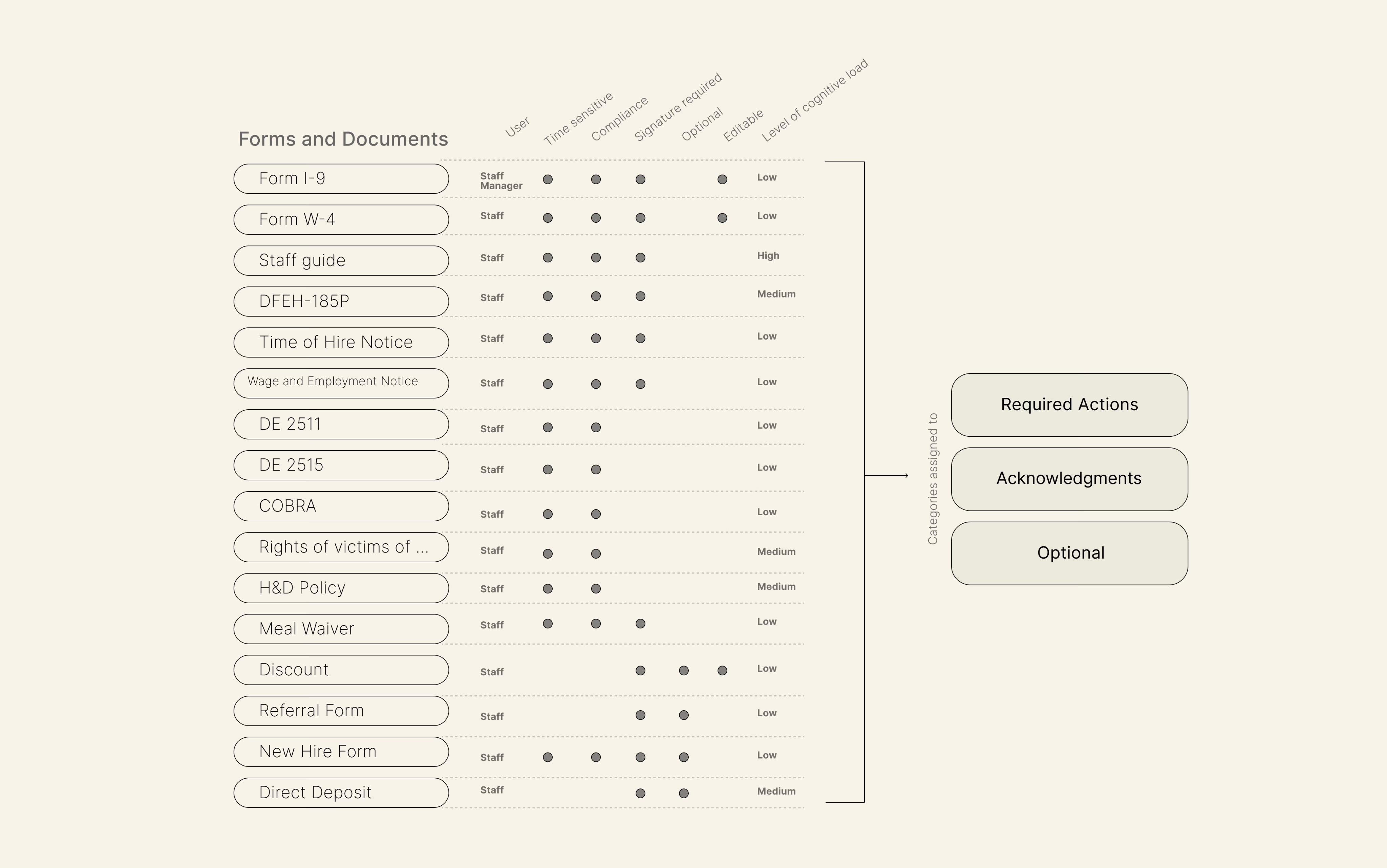
Workflow & Role Redesign
Process alignment
Shifted onboarding from being HR-only to a shared responsibility between People Ops, managers, and new hires.
Accountability Mapping
Defined manager responsibilities clearly (compliance checks, training touchpoints, employee introductions).
Visibility Tools
Built manager-facing dashboards for visibility into onboarding progress.
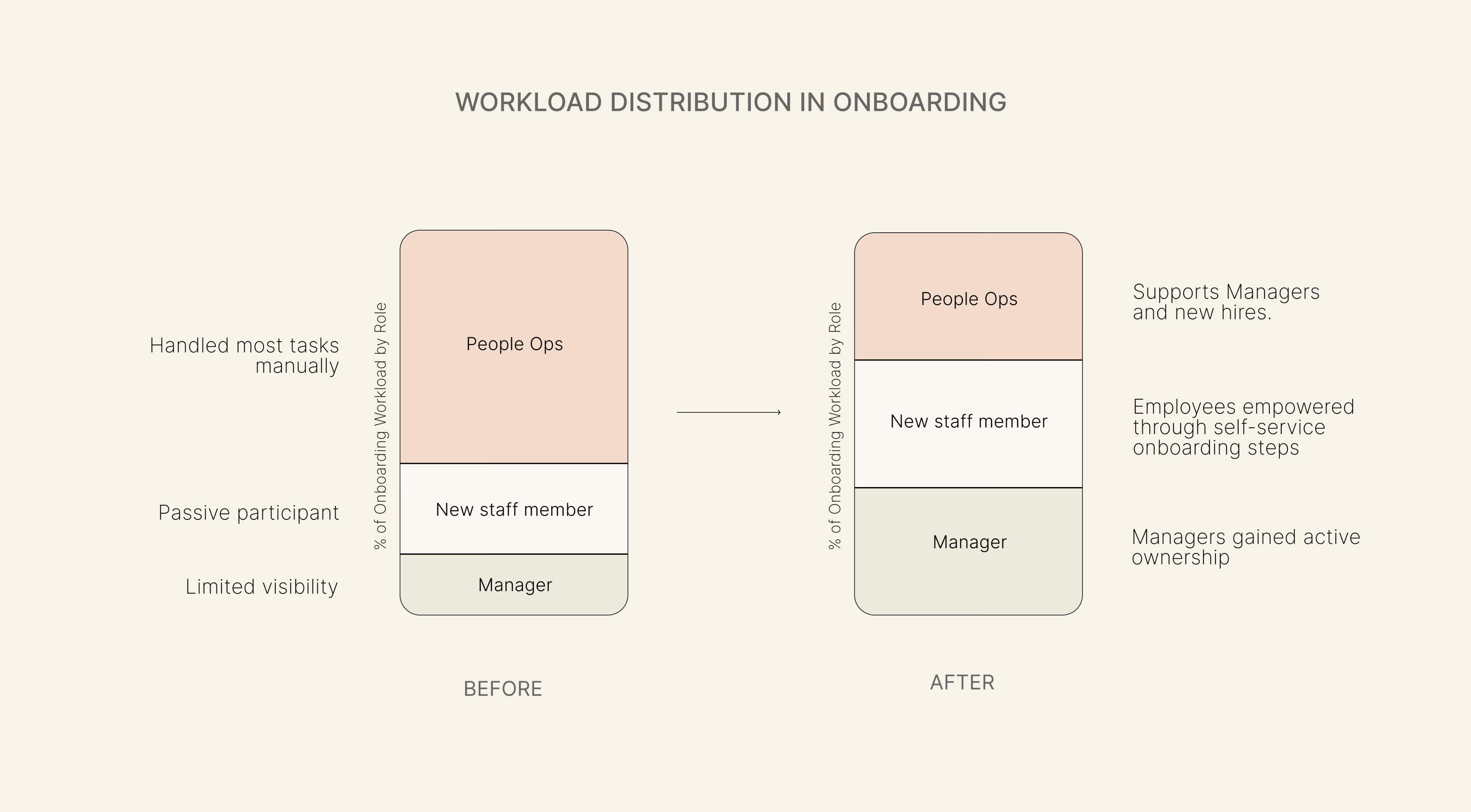
VALIDATION &
IMPLEMENTATION PHASE
I validated the new onboarding workflows through structured testing, role-based accountability, and continuous user support to ensure smooth adoption.
1.
Workflow & System Architecture Design
Mapping the complete onboarding journey and create a seamless, automated process.
System Design
- Designed automated task flows within Paycom to streamline onboarding.
- Implemented a role-based system for task delegation and accountability.
- Enabled real-time tracking and completion monitoring for all onboarding tasks.
- Integrated Monday.com for centralized progress tracking and visibility.
2.
Role-Based Readiness
Defined clear responsibilities for each group:
People Ops
System administration
Compliance oversight
Exception handling
Reporting & analytics
Managers
Compliance checks
Training coordination
Progress monitoring
Employee support
New staff members
Self-service completion
Progress tracking
Document upload
Status monitoring
3.
Training & Communication
Ensuring smooth adoption and user confidence
Training Materials
- Developed clear, user-friendly onboarding instructions tailored to each role.
- Created comprehensive user guides, including bilingual resources (English & Spanish).
- Produced video tutorials and step-by-step guides to simplify system navigation.
4.
Implementation Rollout
- Transitioned fully from paper-based processes to automated onboarding in Paycom.
- Ensured compliance documentation reached 100% accuracy.
- Empowered HR to refocus on strategic initiatives by reducing repetitive tasks.
Results & Impact
The digital transformation delivered significant improvements across efficiency, compliance, and user experience.
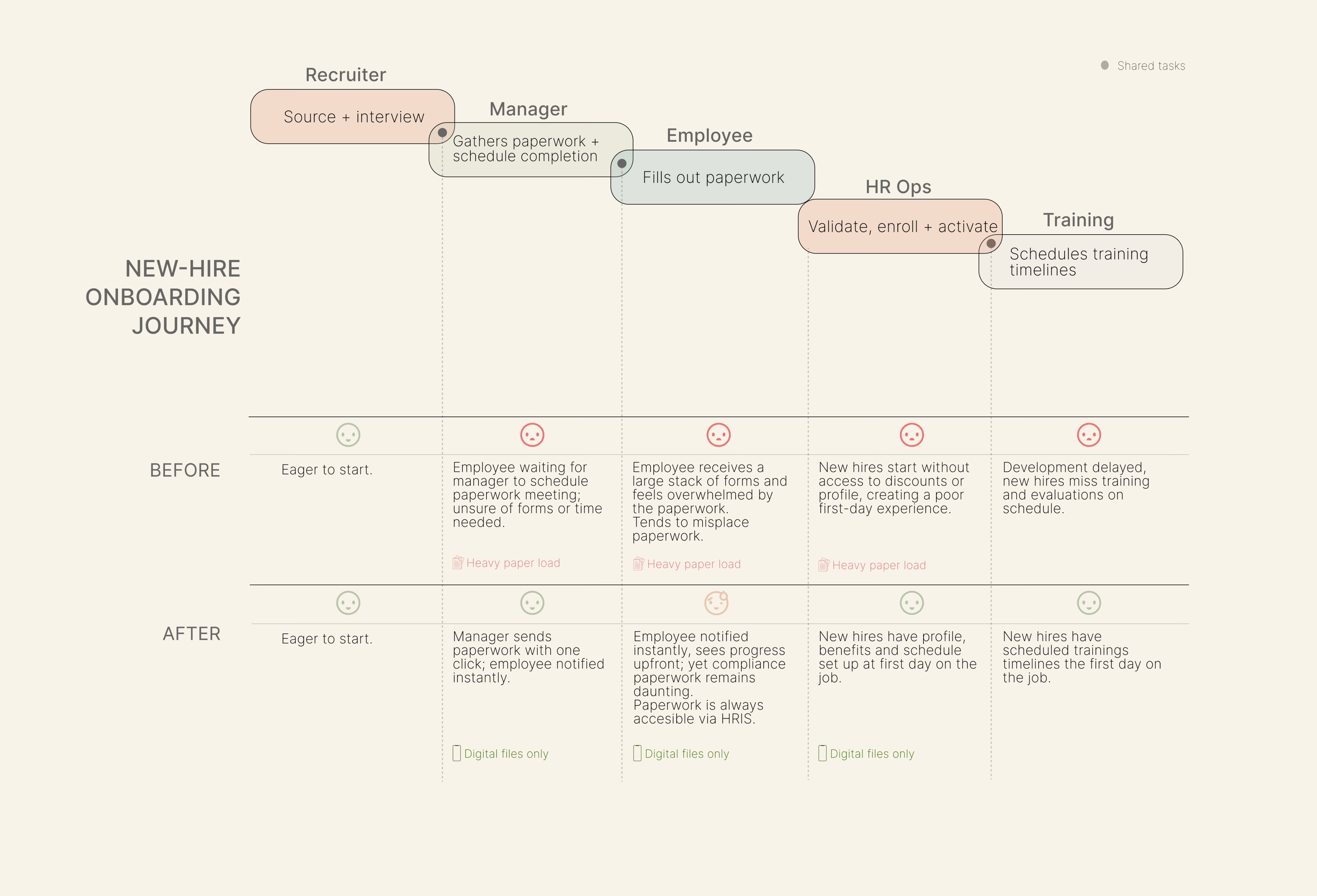
Quantitative Results
Data Entry Errors
Significant reduction in manual errors
-75%
Documentation Compliance
Up from 85% baseline
100%
Processing Time
Reduced onboarding duration
-65%
Qualitative Impact
People Ops Benefits
Gained clearer responsibilities, improved coordination, and stronger employee relationships through active onboarding participation.
Manager Experience
Gained clearer responsibilities, improved coordination, and stronger employee relationships through active onboarding participation.
Employee Experience
Experienced smoother integration, with bilingual support, self-service onboarding, and transparent progress tracking.
Key Takeaways & Learnings
Critical insights and lessons learned from transforming a manual process into a digital-first experience.
Success Factors
User Research Drove Adoption → Engaging HR, managers, and employees ensured the solution solved real needs.
Standardization Created Confidence → A repeatable process reduced inconsistencies and made onboarding scalable.
Early Engagement Improved Retention → Introducing new hires to the HRIS early boosted familiarity and reduced friction for future procesess.
Design Principles Validated
Shared Responsibility Builds Trust → Shifting accountability from HR alone to HR + managers strengthened relationships.
Automation Delivers Reliability → Digitization reduced workload, minimized errors, and ensured compliance.
Transparency Reinforces Inclusion → Progress tracking gave employees visibility, signaling the company’s commitment to their success.
Future Opportunities
Areas for continuous improvement to further elevate onboarding.
Analytics & Insights
• Bottleneck and retention tracking
• Manager performance metrics
Experience Enhancement
• Personalized onboarding journeys by position
• Interactive, gamified training modules
• Peer connection features
Automating the First Hello
Building a digital-first onboarding experience that transformed manual processes into a streamlined, scalable platform for new hire success.
Process Automation
User Research
Workflow Design
Compliance

65%
Reduced onboarding time per month.
100%
Documentation compliance prior to start date.
75%
Reduced data entry errors
95%
New hires fully operational by Day 1
Project Overview
I transformed Company’s outdated, paper-based onboarding process into a modern, digital-first platform that streamlined workflows, reduced errors, and ensured compliance. The new system empowered People Ops, managers, and employees with clarity, efficiency, and inclusivity. This project wasn’t just about saving time, it was about creating a welcoming, scalable onboarding experience for every new hire.

My role
Process Design Lead & Implementation Manager
- Led discovery with HR and managers to identify inefficiencies and compliance risks.
- Designed and implemented automated workflows in Paycom to reduce errors.
- Guided the transition to a digital platform, standardizing processes across locations.
- Built a centralized tracking system in Monday.com for real-time onboarding visibility.
Project goals
- Replace manual workflows with a scalable, automated system.
- Reduce potential compliance risks and eliminate data entry errors.
- Empower managers and employees with self-service onboarding tools.
- Provide bilingual accessibility to support a diverse workforce
Impact
- Cut onboarding processing time by 65%, saving 26+ HR hours/month.
- Reduced data entry errors by 75%, improving compliance and accuracy.
- Raised documentation compliance to 100% pre-start (from 85%).
- Increased onboarding completion rate from 50% → 95% within 7 days, ensuring timely access to systems and perks.
The Challenge
Company’s rapid growth and high turnover created a pressing need for a scalable, structured onboarding solution. The existing manual, paper-based process was slow, error-prone, and failed to support a diverse bilingual workforce. Without visibility into progress, both employees and managers experienced delays and frustration, while People Ops carried the burden of repetitive administrative work.

Current State Problems
Manual Paper-Based Process
Required bilingual staff to process all documentation by hand.
High Error Rates
Manual data entry led to compliance risks and processing delays.
Fragmented Workflow
Managers and employees lacked visibility into onboarding progress.
Excessive HR Workload
Required bilingual staff to process all documentation by hand.
Business Impact
Digital Centralization
To automate all onboarding tasks within the HRIS platform.
Standardization & Scalability
A consistent process that adapts to seasonal hiring and growth.
Self-Service Capabilities
Tools that allow managers and employees to complete onboarding independently.
Bilingual Accessibility
English and Spanish resources to support a diverse workforce.
User Center Design Process
Discovery PHASE
To design a seamless and inclusive onboarding experience, I conducted research to uncover inefficiencies, pain points, and opportunities for improvement.
User research &
stakeholder interviews
Pain points & challenges
Identified frustrations, inefficiencies, and compliance risks in the current manual process.
Time & effort analysis
Measured how long each onboarding task took, from locating documents in the file share to employee system access.
Legal & Compliance considerations
Determined which documents, signatures and approvals were essential to remain compliant.
Training & accountability needs
Evaluated how involved managers should be in onboarding and defined their responsibilities.
Process mapping &
requirement gathering
Document management
Tracked where People Ops accessed and printed forms, when documents were distributed, and how they were collected.
Related processes
Mapped out the dependencies between onboarding and other People Ops workflows to streamline handoffs and prevent bottlenecks.
Task ownership
Defined clear responsibilities between People Ops, managers, and new hires.
Industry research
Applied SHRM recommendations, benchmarked case studies, and studied the psychological impact of onboarding on retention and belonging.

Key Research Insights
Through comprehensive research, I identified critical pain points and opportunities to transform the onboarding process:
- Manual processes slowed onboarding and increased HR workload.
- Compliance risks grew due to fragmented workflows and undocumented handoffs.
- Employees lacked visibility, leading to disengagement and frustration.
- Managers wanted clearer accountability to better support their teams.
- Automation + bilingual support were critical to ensure equity and scalability.
Design PHASE
I structured an efficient and scalable onboarding experience that balanced compliance, usability, and employee engagement of the two main elements: Information architecture and workflow + role redesign .
I designed an onboarding flow that balanced compliance with a welcoming, low-stress experience. To make the process clear and approachable, I organized tasks into three categories so employees could focus on what mattered most without feeling overwhelmed.
Information Architecture Strategy
Required Actions
Critical compliance steps employees had to complete right away (I-9 verification, tax forms, direct deposit, emergency contacts). This ensured legal requirements were never delayed.
Acknowledgments
Important policies and documents grouped together for easy review and confirmation (handbook, safety policies, code of conduct, privacy notices). This kept consistency across all hires.
Optional Items
Helpful extras like onboarding tips, training guides, and benefits overviews, designed to empower employees without cluttering the essentials.

Workflow & Role Redesign
Process alignment
Shifted onboarding from being HR-only to a shared responsibility between People Ops, managers, and new hires.
Accountability Mapping
Defined manager responsibilities clearly (compliance checks, training touchpoints, employee introductions).
Visibility Tools
Built manager-facing dashboards for visibility into onboarding progress.

VALIDATION & IMPLEMENTATION PHASE
I validated the new onboarding workflows through structured testing, role-based accountability, and continuous user support to ensure smooth adoption.
1.
Workflow & System Architecture Design
Mapping the complete onboarding journey and create a seamless, automated process.
System Design
- Designed automated task flows within Paycom to streamline onboarding.
- Implemented a role-based system for task delegation and accountability.
- Enabled real-time tracking and completion monitoring for all onboarding tasks.
- Integrated Monday.com for centralized progress tracking and visibility.
2.
Role-Based Readiness
Defined clear responsibilities for each group:
People Ops
System administration
Compliance oversight
Exception handling
Reporting & analytics
Managers
Compliance checks
Training coordination
Progress monitoring
Employee support
New staff members
Self-service completion
Progress tracking
Document upload
Status monitoring
3.
Training & Communication
Ensuring smooth adoption and user confidence
Training Materials
- Developed clear, user-friendly onboarding instructions tailored to each role.
- Created comprehensive user guides, including bilingual resources (English & Spanish).
- Produced video tutorials and step-by-step guides to simplify system navigation.
4.
Implementation Rollout
- Transitioned fully from paper-based processes to automated onboarding in Paycom.
- Ensured compliance documentation reached 100% accuracy.
- Empowered HR to refocus on strategic initiatives by reducing repetitive tasks.
Results & Impact
The digital transformation delivered significant improvements across efficiency, compliance, and user experience.
Quantitative Results
Data Entry Errors
Significant reduction in manual errors
-75%
Documentation Compliance
Up from 85% baseline
100%
Processing Time
Reduced onboarding duration
-65%
Qualitative Impact
People Ops Benefits
Gained clearer responsibilities, improved coordination, and stronger employee relationships through active onboarding participation.
Manager Experience
Gained clearer responsibilities, improved coordination, and stronger employee relationships through active onboarding participation.
Employee Experience
Experienced smoother integration, with bilingual support, self-service onboarding, and transparent progress tracking.

Key Takeaways & Learnings
Critical insights and lessons learned from transforming a manual process into a digital-first experience.
Success Factors
User Research Drove Adoption → Engaging HR, managers, and employees ensured the solution solved real needs.
Standardization Created Confidence → A repeatable process reduced inconsistencies and made onboarding scalable.
Early Engagement Improved Retention → Introducing new hires to the HRIS early boosted familiarity and reduced friction for future processes.
Design Principles Validated
Shared Responsibility Builds Trust → Shifting accountability from HR alone to HR + managers strengthened relationships.
Automation Delivers Reliability → Digitization reduced workload, minimized errors, and ensured compliance.
Transparency Reinforces Inclusion → Progress tracking gave employees visibility, signaling the company’s commitment to their success.
Future Opportunities
Areas for continuous improvement to further elevate onboarding.
Analytics & Insights
• Bottleneck and retention tracking
• Manager performance metrics
Experience Enhancement
• Personalized onboarding journeys by position
• Interactive, gamified training modules
• Peer connection features
